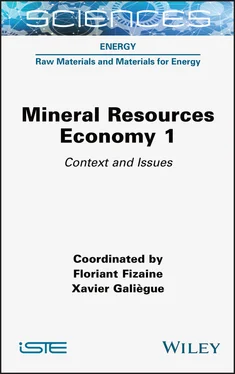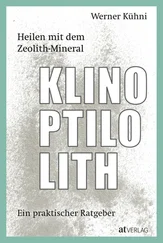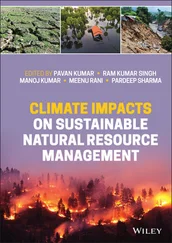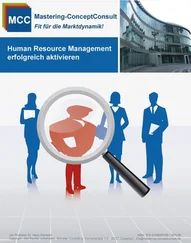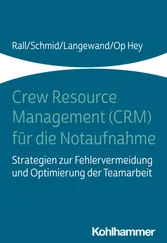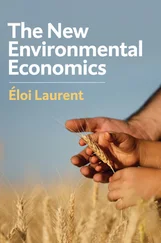Measuring the environmental footprint of mineral resources is a challenge that Jacques Villeneuve and his co-authors at BRGM propose to take up ( Chapter 6). Indeed, the environmental footprint of human activities goes beyond its sole measurement in terms of surface area used to take into account all the environmental impacts on the lifecycle of products. The aim here is to measure this footprint using an extended input–output table (IOT) that determines the consumption of mineral resources and their environmental impacts, induced by final demand with a fine level of disaggregation. These IOTs are then interconnected within a multi-regional model to assess the final impact, including imports, of national demand. In spite of limitations related to the difficulty of obtaining databases comparing data on a global scale, it can be seen that the environmental footprint of the demand for metals required for French final demand is mainly made abroad.
Since the use of mineral resources is part of an economic issue, Romain Debref ( Chapter 7) is interested in aspects related to environmental efficiency (energy and material) often implemented in many technologies in order to save resources and energy. He gives an overview of the history of eco-efficiency through the various movements that support it and its limits in terms of the originality and purpose of the concept. In a second step, he details the many forms of rebound effects that still hinder eco-efficiency.
We tend to forget this, but most of our consumption of raw materials requires some countries to specialize in the extraction of these resources. Yet a significant number of these countries have poorer economic health than countries without resources. Audrey Aknin ( Chapter 8) shows the main factors that contribute to this resource curse. Far from the simple paradox of abundance, the resource curse is rooted in a variety of channels such as Dutch disease, increased income-seeking behavior, organizational failure, institutional dysfunction, corruption and civil war. The chapter also provides an overview of the recurrent failure of the various tools supported by international organizations to contain these phenomena. The author concludes with a few examples of countries that have successfully avoided the resource curse and the options that are now favored.
The increase in the supply of mineral resources also faces social and legal issues. Thus, Victoire Girard and Agnès Zabsonré ( Chapter 9) demonstrate that the exploitation of natural resources can make a major contribution to the process of economic growth and development and that a significant part of the populations of low-income countries depend on the exploitation of mineral resources through artisanal mining. The impact of this exploitation is a controversial issue, leading to a resource curse in some cases, or economic benefits in others. Industrial mining can certainly have some positive local economic impacts, depending on the quality of governance of local institutions and their ability to create economic benefits for related industries. However, artisanal mining appears to have a greater positive effect on the consumption, incomes and well-being of the local population. The long-term impacts on well-being, as well as on health through local pollution, are more uncertain and should be better documented by further research.
In Volume 2, Emmanuel Hache and his co-authors ( Chapter 1) review the criticality approaches recently deployed to analyze the new risk caused by the surge in raw material needs for the energy transition. Their overview of the studies leads them to question the absence of a homogeneous theoretical framework and to underline the weaknesses of current indicators (the Herfindahl–Hirschman Index (HHI) and the World Governance Index), particularly with regard to geopolitical aspects. While cartelization attempts in raw materials markets have all failed in the past (with the possible exception of OPEC), this fear is resurfacing today given the significant concentration of metal markets for oil. Researchers are showing what is really going on with lithium, cobalt, copper and rare earths. Finally, the authors discuss the values of different forms of public policy to manage commodity supply risk.
We will also see that more mineral resources uses also mean more extraction. However, the opening of new deposits according to their location does not go without posing legal problems. Stéphanie Reiche-de Vigan ( Chapter 2) proposes a review of the different legal regimes affecting mineral resources. She discusses issues related to the domestic law of territorial mineral resources through the French and American cases. The question of the exploitation of mineral resources is posed differently in international law, depending on whether the resources are territorial (in the case of the seabed of the continental shelf) or extraterritorial (the seabed of international waters and the Antarctic). She explains that the current legal regimes are insufficient, often truncated and do not guarantee respect for all aspects of sustainable development.
Finally, Michel Deshaies ( Chapter 3) traces how the presence of mineral resources influences the evolution of settlement mechanisms throughout history. In particular, the author shows that settlement mechanisms present historical, regional and material disparities (differences between metal and coal deposits). He also observes that territories where mining activities are carried out have to overcome several obstacles, such as recurrent conflicts with local populations, and also huge reconversion challenges for the post-mining period.
In a third problematic, we propose to explore the major leverage actions often perceived as answers, or elements of answers, to the challenges mentioned above: domestic mining, substitution, decoupling (or material efficiency), recycling and the sobriety associated with the concept of low-tech.
To begin with, Johan Yans ( Chapter 4) discusses the interest of domestic extraction on European soil. Although still relevant in Europe, production from European countries that have maintained or developed a mining supply remains marginal in comparison with their needs. This inevitably results in a significant dependence of European industries on imports of mineral resources. As the author reminds us, however, there are inherent gains from the domestic extraction of existing and wellcharacterized resources: environmental gains linked to short circuits, the stimulation of local employment and the substitution of imports sometimes extracted under disastrous conditions. Nevertheless, major obstacles remain, such as a lack of professional skills (after training that has fallen into disuse since the 1990s) and above all local opposition generated by an often negative public perception (NIMBY syndrome). This is not inevitable and the author looks at the leverage action likely to reduce these dissensions.
Through the analysis of another unavoidable leverage action, Florian Fizaine ( Chapter 5) proposes to explore the standard theory underlying intra-material substitution. In particular, he returns to the notions of the demand curve, price elasticity and cross-price elasticity of demand while underlining their shortcomings and limitations when applied to mineral resources. In particular, he sheds light on this lack by evoking the heterogeneity of situations according to the different scales of material sub-constitution. Lastly, he concludes by explaining the multiple technical, economic, socio-cultural and legal constraints that limit material substitution.
Thierry Lefèvre ( Chapter 6) reviews empirical studies analyzing the decoupling (dematerialization) between GDP and the various indicators of raw material consumption. He shows that decoupling is at best relative and not absolute, as would be desired by international organizations promoting sustainable development and energy transition. These decoupling indicators also leave aside several important issues, such as inequality and the quality of life of populations. These other dimensions must be taken into account in the future to achieve true sustainable development.
Читать дальше
